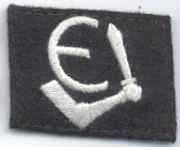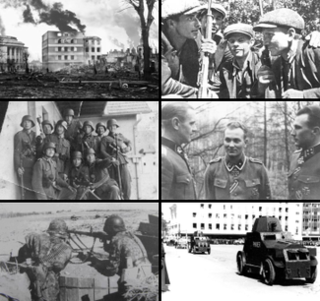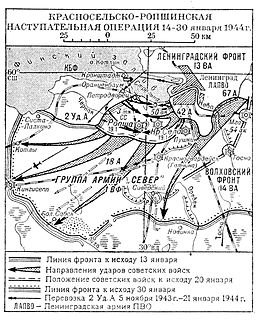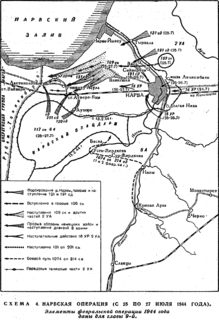| 30th Guards Rifle Corps (1943–1957) 30th Guards Army Corps (1957–1998) | |
|---|---|
| Active | 1943–1998 |
| Country | |
| Branch | Soviet Army |
| Type | Infantry |
| Garrison/HQ | Vyborg |
| Engagements | |
| Decorations | |
| Battle honours | Leningrad |
| Commanders | |
| Notable commanders | Mikhail Panov |
The 30th Guards Leningrad Army Corps (Russian: 30 Гвардейского армейского общевойскового Краснознамённого Ленинградского корпуса) was an army corps of the Soviet Ground Forces. As part of the Red Army during the Great Patriotic War it was designated the 30th Guards Rifle Corps.
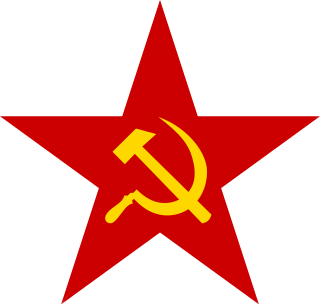
The Workers' and Peasants' Red Army, frequently shortened to Red Army was the army and the air force of the Russian Soviet Federative Socialist Republic, and, after 1922, the Union of Soviet Socialist Republics. The army was established immediately after the 1917 October Revolution. The Bolsheviks raised an army to oppose the military confederations of their adversaries during the Russian Civil War. Beginning in February 1946, the Red Army, along with the Soviet Navy, embodied the main component of the Soviet Armed Forces; taking the official name of "Soviet Army", until its dissolution in December 1991.
It was formed in April 1943 on the basis of three guards rifle divisions, which had distinguished themselves in battle to break through the Siege of Leningrad – the 45th, 63rd and 64th (the last came from the Volkhov Front). So the corps was a Guards unit from the first day of its formation. N. P. Simonyak, who had received for Operation Spark the title of Hero of the Soviet Union, was appointed as commander.

The Siege of Leningrad was a prolonged military blockade undertaken from the south by the Army Group North of Nazi Germany against the Russian city of Leningrad on the Eastern Front in World War II. The Finnish army invaded from the north, co-operating with the Germans until they had recaptured territory lost in the recent Winter War, but refused to make further approaches to the city.

The 64th Guards Rifle Division was created on January 19, 1943 from the 327th Rifle Division, in recognition of that division's distinguished combat record in the Second Siniavino Offensive and Operation Iskra. It was one of a relatively small number of formations raised to Guards status in the northern sector of the Soviet-German Front. As such, it was employed as an assault division in the subsequent fighting, particularly in the final defeat of the German forces before Leningrad, and the final offensive against Finland. The division ended the war in Lithuania, helping to contain the enemy forces trapped in the Courland Pocket, and went on to serve well into the postwar era, still in the Leningrad/St. Petersburg area.
The Volkhov Front was a major formation of the Red Army during the first period of the Second World War. It was formed as an expediency of an early attempt to halt the advance of the Wehrmacht Army Group North in its offensive thrust towards Leningrad. Initially the front operated to the south of Leningrad, with its flank on Lake Ladoga.
Until the second week of February 1944, the two armies of the Leningrad Front had deployed only vanguard elements while attempting to force entry into Estonia. [1] [2] Army General Leonid A. Govorov of Leningrad Front ordered the 2nd Shock Army to break through the German defence line north and south of Narva town, move the front fifty kilometres westwards and continue towards the town of Rakvere. The artillery of the 2nd Shock army opened fire on all German positions on 11 February, continuing the Battle for Narva Bridgehead. The 30th Guards Rifle Corps joined the Soviet units attempting to seize the Auvere station. [2] The guards riflemen widened the bridgehead to ten kilometres along the front. The remains of the German 227th and 170th Infantry Divisions retreated. [1] [3] General Major Romantsov ordered an assault at Auvere settlement by the Air Force and artillery on 13 February, with the 64th Guard Rifle Division seizing the village in a surprise attack. Half a kilometre westward from Auvere station, the 191st Guard Rifle Regiment cut through the railway two kilometres from the Tallinn highway, which was the last way out for Army Group Narwa, but was repelled by the 170th Infantry Division and the 502nd Heavy Panzer Battalion. [1] [3] [4]

The Leningrad Front was formed during the 1941 German approach on Leningrad by dividing the Northern Front into the Leningrad Front and Karelian Front on August 27, 1941.

Estonia, officially the Republic of Estonia, is a country in Northern Europe. It is bordered to the north by the Gulf of Finland with Finland on the other side, to the west by the Baltic Sea with Sweden on the other side, to the south by Latvia (343 km), and to the east by Lake Peipus and Russia (338.6 km). The territory of Estonia consists of a mainland and 2,222 islands in the Baltic Sea, covering a total area of 45,227 km2 (17,462 sq mi), water 2,839 km2 (1,096 sq mi), land area 42,388 km2 (16,366 sq mi), and is influenced by a humid continental climate. The official language of the country, Estonian, is the second most spoken Finnic language.
The 2nd Shock Army was a field army of the Soviet Union during the Second World War. This type of formation was created in accordance with prewar doctrine that called for Shock Armies to overcome difficult defensive dispositions in order to create a tactical penetration of sufficient breadth and depth to permit the commitment of mobile formations for deeper exploitation. However, as the war went on, Shock Armies lost this specific role and reverted, in general, to ordinary frontline formations.
The corps was deployed during the postwar period on the Karelian Isthmus with the headquarters in the city of Vyborg (Leningrad Military District). The corps was disbanded in 1998. In 1988 the corps was reported to consist of the 45th Guards Motor Rifle Division, the 64th Guards Motor Rifle Division, and the 37th Motor Rifle Division (a mobilisation division, the double of the 63rd Motor Rifle Training Division) at Chernaya Rechka. [5]
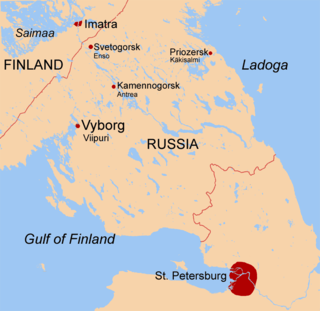
The Karelian Isthmus is the approximately 45–110 km wide stretch of land, situated between the Gulf of Finland and Lake Ladoga in northwestern Russia, to the north of the River Neva. Its northwestern boundary is the relatively narrow area between the Bay of Vyborg and Lake Ladoga. If the Karelian Isthmus is defined as the entire territory of present-day Saint Petersburg and Leningrad Oblast to the north of the Neva, the isthmus' area covers about 15,000 km2.

Vyborg is a town in, and the administrative center of, Vyborgsky District in Leningrad Oblast, Russia. It lies on the Karelian Isthmus near the head of the Vyborg Bay, 130 km to the northwest of St. Petersburg and 38 km south of Russia's border with Finland, where the Saimaa Canal enters the Gulf of Finland. The population of Vyborg has developed as follows: 79,962 (2010 Census); 79,224 (2002 Census); 80,924 (1989 Census)..

The Leningrad Military District was a military district of the Armed Forces of the Russian Federation. In 2010 it was merged with the Moscow Military District, the Northern Fleet and the Baltic Fleet to form the new Western Military District.



